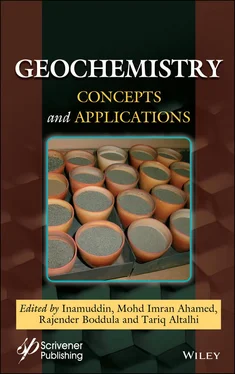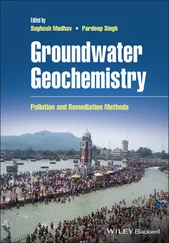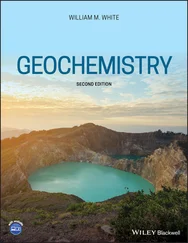4. Gwenzi, W., Occurrence, behaviour, and human exposure pathways and health risks of toxic geogenic contaminants in serpentinitic ultramafic geological environments (SUGEs): A medical geology perspective. Sci. Total Environ. , 700, 134622, https://doi.org/10.1016/j.scitotenv.2019.134622, 2020.
5. Davies, B.E., Bowman, C., Davies, T.C., Selinus, O., Medical geology: Perspectives and prospects, in: Essentials of medical geology , pp. 1–13, Springer, Dordrecht, 2013.
6. Goovaerts, P., Geostatistics: a common link between medical geography, mathematical geology, and medical geology. J. South. Afr. Inst. Min. Metall. , 114, 8, 605–613, 2014.
7. Doocy, S., Daniels, A., Packer, C., Dick, A., Kirsch, T.D., The human impact of earthquakes: a historical review of events 1980-2009 and systematic literature review. PLoS Curr. , 5, 2013, https://currents.plos.org/disasters/index.html%3Fp=6639.html.
8. Kut, K.M.K., Sarswat, A., Srivastava, A., Pittman Jr., C.U., Mohan, D., A review of fluoride in African groundwater and local remediation methods. Groundwater Sustainable Dev. , 2, 190–212, 2016.
9. Oze, C., Fendorf, S., Bird, K.D., Coleman, G.R., Chromium geochemistry in serpentinized ultramafic rocks and serpentine soils from the Franciscan complex of California. Am. J. Sci. , 304, 67–101, 2004.
10. Gwenzi, W., Mangori, L., Danha, C., Chaukura, N., Dunjana, N., Sanganyado, E., Sources, behaviour, and environmental and human health risks of high-technology rare earth elements as emerging contaminants. Sci. Total Environ. , 636, 299–313, 2018.
11. Sleep, N.H., Meibom, A., Fridriksson, T., Coleman, R.G., Bird, D.K., H2-rich fluids from serpentinization: geochemical and biotic implications. Proc. Natl. Acad. Sci. , 101, 35, 12818–12823, 2004.
12. Rajapaksha, A.U., Vithanage, M., Oze, C., Bandara, W.M.A.T., Weerasooriya, R., Nickel and manganese release in serpentine soil from the Ussangoda Ultramafic Complex, Sri Lanka. Geoderma , 189, 1–9, 2012.
13. Manning, A.H., Mills, C.T., Morrison, J.M., Ball, L.B., Insights into controls on hexavalent chromium in groundwater provided by environmental tracers, Sacramento Valley, California, USA. Appl. Geochem. , 62, 186–199, 2015.
14. Blades, M.L., Foden, J., Collins, A.S., Alemu, T., Woldetinsae, G., The origin of the ultramafic rocks of the Tulu Dimtu Belt, western Ethiopia–do they represent remnants of the Mozambique Ocean? Geol. Mag. , 156, 62–82, 1–21, 2017.
15. Antoniadis, V., Golia, E.E., Liu, Y.T., Wang, S.L., Shaheen, S.M., Rinklebe, J., Soil and maize contamination by trace elements and associated health risk assessment in the industrial area of Volos, Greece. Environ. Int. , 124, 79–88, 2019.
16. Oberthür, T., Davis, D.W., Blenkinsop, T.G., Höhndorf, A., Precise U-Pb mineral ages, Rb-Sr and Sm-Nd systematics for the Great Dyke, Zimbabwe - constraints on crustal evolution and metallogenesis of the Zimbabwe Craton. Precambrian Res. , 113, 293–306, 2002.
17. Stribrny, B., Wellmer, F.-W., Burgath, K.-P., Oberthür, T., Tarkian, M., Pfeiffer, T., Unconventional PGE occurrences and PGE mineralization in the Great Dyke: metallogenic and economic aspects. Miner. Deposita , 35, 260–281, 2000.
18. Morrison, J.M., Goldhaber, M.B., Mills, C.T., Breit, G.N., Hooper, R.L., Holloway, J.A.M., Diehl, S.F., Ranville, J.F., Weathering and transport of chromium and nickel from serpentinite in the coast range ophiolite to the Sacramento Valley, California, USA. Appl. Geochem. , 61, 72–86, 2015.
19. Alexander, E.B. and DuShey, J., Topographic and soil differences from peridotite to serpentinite. Geomorphology , 135, 271–276, 2011.
20. Oury, T.D., Sporn, T.A., Roggli, V.L. (Eds.), Pathology of asbestos-associated diseases , p. 357, Springer, Berlin, 2014.
21. Bloise, A., Barca, D., Gualtieri, A.F., Pollastri, S., Belluso, E., Trace elements in hazardous mineral fibres. Environ. Pollut. , 216, 314–323, 2016a.
22. Bloise, A., Punturo, R., Catalano, M., Miriello, D., Cirrincione, R., Naturally occurring asbestos (NOA) in rock and soil and relation with human activities: the monitoring example of selected sites in Calabria (southern Italy). Ital. J. Geosci. , 135, 2, 268–279, 2016b.
23. Gualtieri, A.F., Lusvardi, G., Zoboli, A., Di Giuseppe, D., Gualtieri, M.L., Biodurability and release of metals during the dissolution of chrysotile, crocidolite and fibrous erionite. Environ. Res. , 171, 550–557, 2019.
24. Holmes, E.P., Wilson, J., Schreier, H., Lavkulich, L.M., Processes affecting surface and chemical properties of chrysotile: Implications for reclamation of asbestos in the natural environment. Can. J. Soil Sci. , 92, 1, 229–242, 2012.
25. Holmes, E.P. and Lavkulich, L.M., The effects of naturally occurring acids on the surface properties of chrysotile asbestos. J. Environ. Sci. Health, Part A , 49, 12, 1445–1452, 2014.
26. Bales, R.C., Surface chemical and physical behavior of chrysotile asbestos in natural waters and water treatment , Keck Laboratories of Environmental Engineering Science, Division of Engineering and Applied Science, California Institute of Technology, Pasadena, CA. Report No. AC-8-84, 1984.
27. Bangira, C., Deng, Y., Loeppert, R.H., Hallmark, C.T., Stucki, J.W., Soil mineral composition in contrasting climatic regions of the Great Dyke, Zimbabwe. Soil Sci. Soc. Am. J. , 75, 6, 2367–2378, 2011.
28. Shallari, S., Schwartz, C., Hasko, A., Morel, J.L., Heavy metals in soils and plants of serpentine and industrial sites of Albania. Sci. Total Environ. , 209, 2–3, 133–142, 1998.
29. Vengosh, A., Coyte, R., Karr, J., Harkness, J.S., Kondash, A.J., Ruhl, L.S., Merola, R.B., Dywer, G.S., Origin of hexavalent chromium in drinking water wells from the piedmont aquifers of North Carolina. Environ. Sci. Technol. Lett. , 3, 12, 409–414, 2016.
30. Namgung, S., Kwon, M.J., Qafoku, N.P., Lee, G., Cr(OH) 3(s) oxidation induced by surface catalyzed Mn (II) oxidation. Environ. Sci. Technol. , 48, 18, 10760–10768, 2014.
31. Dotaniya, M.L. and Meena, V.D., Rhizosphere effect on nutrient availability in soil and its uptake by plants: a review. Proc. Natl. Acad. Sci. India Sect. B: Biol. Sci. , 85, 1, 1–12, 2015.
32. Paulick, H., Bach, W., Godard, M., De Hoog, J.C.M., Suhr, G., Harvey, J., Geochemistry of abyssal peridotites (Mid-Atlantic Ridge, 15820’N, ODP Leg 209): Implications for fluid/rock interaction in slow spreading environments. Chem. Geol. , 234, 179–210, 2006.
33. Kodolányi, J., Pettke, T., Spandler, C., Kamber, B.S., Gméling, K., Geochemistry of ocean floor and fore-arc serpentinites: constraints on the ultramafic input to subduction zones. J. Petrol. , 53, 2, 235–270, 2011.
34. Scambelluri, M., Rampone, E., Piccardo, G.B., Fluid and element cycling in subducted serpentinite: a trace-element study of the Erro–Tobbio high-pressure ultramafites (Western alps, NW Italy). J. Petrol. , 42, 1, 55–67, 2001.
35. Paulick, H. and Machacek, E., The global rare earth element exploration boom: an analysis of resources outside of China and discussion of development perspectives. Res. Policy , 52, 134–153, https://doi.org/10.1016/j.resourpol.2017.02.002, 2017.
36. WHO (World Health Organization), Chrysotile asbestos , World Health Organization, Geneva, 2014.
37. Davies, T.C. and Mundalamo, H.R., Environmental health impacts of dispersed mineralisation in South Africa. J. Afr. Earth Sci. , 58, 4, 652–666, 2010.
38. Camargo, M.C., Stayner, L.T., Straif, K., Reina, M., Al-Alem, U., Demers, P.A., Landrigan, P.J., Occupational exposure to asbestos and ovarian cancer: a meta-analysis. Environ. Health Perspect. , 119, 9, 1211–1217, 2011.
Читать дальше



